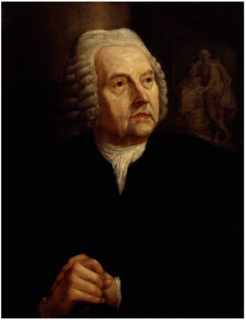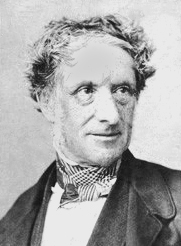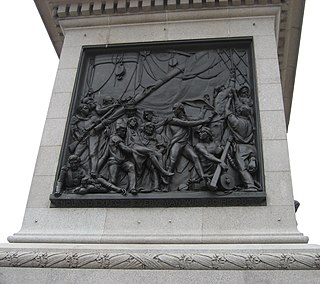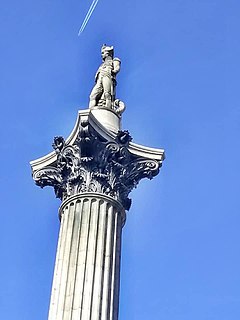
John Francis Moore (died 1809) was a sculptor who was active in late 18th century Britain. His works include two memorials in Westminster Abbey.

John Francis Moore (died 1809) was a sculptor who was active in late 18th century Britain. His works include two memorials in Westminster Abbey.
Moore was of British extraction but was born in Hanover, Germany around 1725. [1] While he was presumably raised and educated in Germany he moved to Britain around 1760. In 1766 his first presentation to the Society of Arts is noted: a relief sculpture entitled Britannia Reviver of Antique, Prompter to Modern Art.
Moore was married to Mary, only daughter and sole heir of John Early (d.1748), a corn chandler and proprietor, by whom he had three sons, John Francis, Charles and James (d.1816) and three daughters, Maria Teresa, Elizabeth Ann and Frances Agnes.
His eldest son, John Francis Moore the younger (d.1793) was also a sculptor but of lesser note. He died young and his father thereafter went into partnership with a 'J. Smith' from 1790 onwards. Moore's youngest sons followed their father's artistic career and became painters.
Moore's granddaughter Elizabeth Moore (1791-1864) of Leyton, Essex was married to Lord Mayor of London and wine merchant John Kinnersley Hooper (1791-1854).
Moore died on 21 January 1809 at Wells Street off Oxford Street, London.
see [2]

Thomas Banks was an important 18th-century English sculptor.

Peter Scheemakers or Pieter Scheemaeckers II or the Younger was a Flemish sculptor who worked for most of his life in London. His public and church sculptures in a classicist style had an important influence on the development of modern sculpture in England.

Joseph Wilton was an English sculptor. He was one of the founding members of the Royal Academy in 1768, and the academy's third keeper. His works are particularly numerous memorialising the famous Britons in Westminster Abbey.

William Behnes was a British sculptor of the early 19th century.

Sir Richard Westmacott was a British sculptor.

Johannes Michel or John Michael Rysbrack, original name Jan Michiel Rijsbrack, often referred to simply as Michael Rysbrack, was an 18th-century Flemish sculptor, who spent most of his career in England where he was one of the foremost sculptors of monuments, architectural decorations and portraits in the first half of the 18th century. His style combined the Flemish Baroque with Classical influences. He operated an important workshop whose output left an important imprint on the practice of sculpture in England.

John Edward Carew was a notable Irish sculptor during the 19th century. His most prominent work is The Death of Nelson, one of the four bronze panels on the pedestal of Nelson's Column in Trafalgar Square.
John Ternouth (1796–1848) was an English sculptor of the early 19th century. His most notable work is one of the four panels at the base of Nelson's Column in London's Trafalgar Square, depicting the Battle of Copenhagen.

Francis Bird (1667–1731) was one of the leading English sculptors of his time. He is mainly remembered for sculptures in Westminster Abbey and St Paul's Cathedral. He carved a tomb for the dramatist William Congreve in Westminster Abbey and sculptures of the apostles and evangelists on the exterior of St Paul's, a memorial to William Hewer in the interior of St Paul's Church, Clapham as well as the statue of Henry VI in School Yard, Eton College. Despite his success, later in life Bird did little sculpting. He had inherited money from his father-in-law and set up a marble import business.
Sir Henry Cheere, 1st Baronet was a renowned English sculptor and monumental mason. He was the older brother of John Cheere, also a notable sculptor.

John Bacon (1777–1859), also known as John Bacon the Younger, or Junior, to distinguish him from his equally famous father, was an English sculptor.

William Tyler was an English sculptor, landscaper, and architect, and one of the three founding members of the Royal Academy, in 1768. He was Director of the Society of Artists.

Peter Rouw II was a London-based sculptor specialising in bas-reliefs in marble, often in the form of mural church monuments, and in wax miniature portraits, often of a pink hue on black glass. He designed medals, including one of William Wilberforce, and also made a few marble busts. He exhibited at the Royal Academy of Arts. In 1807 Rouw was appointed modeller of cameos and gems to the Prince Regent.
Sebastian Gahagan was a sculptor of Irish descent active in London. His most notable works are the monument to Sir Thomas Picton in St Paul's Cathedral, and a statue of the Duke of Kent in Park Crescent, Portland Place. He was also employed by Joseph Nollekens, carrying out the carving of many of his major works.

Peter Turnerelli (c.1772–1839) was an Irish-born sculptor of Italian descent working in Britain in the early 19th century.
Richard Hayward (1725–1800) was an 18th-century British sculptor. He has several works in Westminster Abbey.
James Smith (1775–1815) was an early 18th century English sculptor.

Charles Harriott Smith (1792–1864) was an English architect and architectural sculptor involved in several prestigious projects, ranging from the National Gallery to the Houses of Parliament. His iconic works include the capital of Nelson's Column supporting the statue by Edward Hodges Baily.

Peter Matthias Van Gelder or Vangelder (1739–1809) was an 18th century British sculptor, architect and builder of Dutch descent.
Thomas Denman (1787–1861) was a 19th century English sculptor.